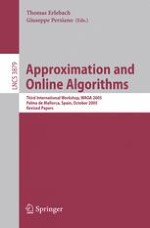The third Workshop on Approximation and Online Algorithms (WAOA 2005) focused on the design and analysis of algorithms for online and computationally hard problems. Both kinds of problems have a large number of applications from a variety of ?elds. WAOA 2005 took place in Palma de Mallorca, Spain, on 6–7 October 2005. The workshop was part of the ALGO 2005 event that also hosted ESA, WABI, and ATMOS. The two previous WAOA workshops were held in Budapest (2003) and Rome (2004). Topics of interest for WAOA 2005 were: algorithmic game theory, appro- mation classes, coloring and partitioning, competitive analysis, computational ?nance, cuts and connectivity, geometric problems, inapproximability results, mechanism design, network design, packing and covering, paradigms, rand- izationtechniques,real-worldapplications,andschedulingproblems.Inresponse to the call for papers we received 68 submissions. Each submission was reviewed by at least three referees, and the vast majority by at least four referees. The submissions were mainly judged on originality, technical quality, and relevance to the topics of the conference. Based on the reviews, the Program Committee selected 26 papers. We are grateful to Andrei Voronkov for providing the EasyChair conference system,whichwasusedtomanagetheelectronicsubmissions,thereviewprocess, and the electronic PC meeting. It made our task much easier. We would also like to thank all the authors who submitted papers to WAOA 2005 as well as the local organizers of ALGO 2005.
